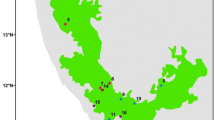Abstract
The city of Jodhpur (26°18′N, 73°8′E) supports a population of about 900 hanuman langurs (Presbytis entellus) divided into 24 bisexual troops and 12 all-male bands in an area of 60 km2. This population has been censused from 1968 to 1978. Over this period the population of bisexual troops has remained stable around 700, while the population of all-male bands has increased from 160 to 230 individuals. The bisexual troops show a tendency towards a reduction in population growth rate with increasing troop size, with troops over 50–60 tending to split. Very small troops may grow by large scale immigration. Although a number of male changes and mortality through infanticide have been recorded, there is no evidence of a regular periodicity in the occurrence of initial, growth and mature phases in the life history of a bisexual troop.
Unlike the bisexual troops, the all-male bands show no tendency towards a reduction in growth rate with the increase in band size, but show a continuous growth of band size over the study period. Langurs of Jodhpur rely heavily on cultivated fields for their sustenance. This cultivation has been on increase over the study period, and since the males invade cultivation more readily, they may have been able to take fuller advantage of these increasing resources and affect a population increase that has not been possible for the bisexual troops.
Similar content being viewed by others
References
Hrdy, S. B., 1977.The Langurs of Abu: Female and Male Strategies of Reproduction. Harvard Univ. Press, Cambridge, Massachusetts.
Makwana, S. C., 1979. Infanticide and social change in two groups of the Hanuman langur,Presbytis entellus, at Jodhpur.Primates, 20: 293–300.
Mohnot, S. M., 1971a. Some aspects of social changes and infant killing in the Hanuman langur,Presbytis entellus (Primates: Cercopithecidae) in Western India.Mammalia, 35: 175–198.
————, 1971b. Ecology and behaviour of the Hanuman langurPresbytis entellus (Primates: Cercopithecidae) invading fields, gardens, orchards around Jodhpur, Western India.Trop. Ecol., 12: 237–249.
Ripley, S., 1967. Intertroop encounters among Ceylon gray langurs (Presbytis entellus). In:Social Communication among Primates,S. A. Altmann (ed.), Chicago Univ. Press, Chicago, pp. 237–253.
Roonwal, M. L. &S. M. Mohnot, 1977.Primates of South Asia: Ecology, Sociobiology and Behaviour. Harvard Univ. Press, Cambridge, Massachusetts.
Sugiyama, Y., 1965. On the social change of the Hanuman langur (Presbytis entellus) in their natural condition.Primates, 6: 381–418.
Author information
Authors and Affiliations
About this article
Cite this article
Mohnot, S.M., Gadgil, M. & Makwana, S.C. On the dynamics of the hanuman langur populations of jodhpur (Rajasthan, India). Primates 22, 182–191 (1981). https://doi.org/10.1007/BF02382609
Issue Date:
DOI: https://doi.org/10.1007/BF02382609




